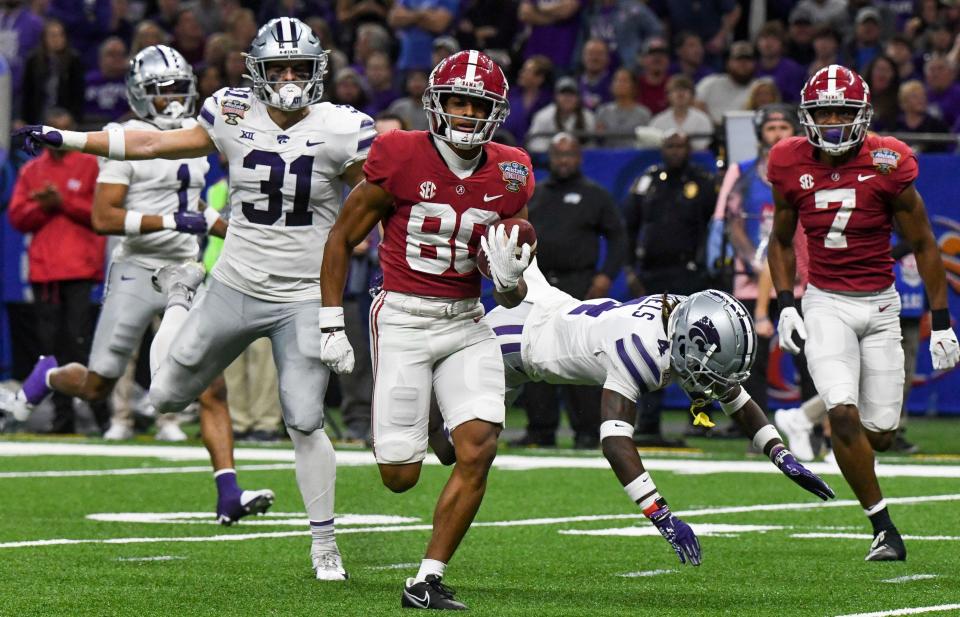Why the SEC and Big 12 can have thriving college football rivalry
The SEC’s next invasion of Big 12 terrain will occur in 2024.
This one, though, only really affects sports hacks like me who cover college football. SEC Media Days will navigate to Dallas next July, conference commissioner Greg Sankey announced Monday. This is hardly a paradigm-shifting development, but it’s notable because the Big 12 conducts its annual preseason media bash at AT&T Stadium in Arlington, Texas.
Once again, the SEC will flex some muscle in a region that used to belong to the Big 12. The SEC’s so-called "talkin’ season" going to Dallas will be a direct reminder of how the SEC raided the Big 12 to grow in number, influence, territory and financial might. The SEC’s past two expansions came at the Big 12’s expense – first Texas A&M and Missouri, then Oklahoma and Texas.
That growth elevated the SEC into super-conference stratum, and the Big Ten paralleled the SEC’s ascent as the Power Five morphed into a Super Two.
A battle is underway between the remaining Power Five leagues to claim that No. 3 conference perch.

Despite its membership losses, the Big 12 is best positioned to claim that spot, a credit to how its commissioner, Brett Yormark, steadied the conference after it lost Oklahoma and Texas. Yormark struck a new media rights deal that will keep the Big 12 on the ESPN and FOX airwaves, and he rounded up four quality additions − Brigham Young, Cincinnati, Central Florida and Houston − that will begin Big 12 competition this year.
Still, the Big 12 harbors some hurt feelings, which became apparent when some of its most prominent voices directed zingers at former or departing members.
BEST COLLEGE FOOTBALL TRADITIONS: SEC | Big Ten | Big 12 | ACC | Pac-12
NO NECKTIES: How SEC commissioner Sankey honored Mike Leach
TCU football coach Sonny Dykes recently belittled the SEC performances of Missouri and Texas A&M, and Oklahoma State football coach Mike Gundy lamented that Oklahoma's Big 12 exit will end the Bedlam rivalry. Yormark downplayed the reality of his conference losing two members that gobble of blue-chip football talent.
Such comments make the Big 12 sound like a jealous ex, but for the conference to best position itself for the future, it should embrace the SEC as, if not an ally, at least a potential partner to enhance its business opportunities and perception.
What better way for the Big 12 to show it belongs in the conversation with the Super Two than by beating SEC teams on the field?
Big 12 teams should seize any chance to play Missouri, Oklahoma, Texas and Texas A&M. Gundy is looking at this wrong. If Oklahoma State punched back at Oklahoma on the field, that would serve as the ultimate revenge, not to mention improving the Pokes' standing for a 12-team College Football Playoff.
Several other SEC members, such as Alabama, Arkansas, Auburn, Ole Miss and Mississippi State, make for logical nonconference opponents, too.
The SEC's top rung clearly outpaces the Big 12's. For evidence, consult the score of the national championship game in January. But the Big 12 still boasts plenty of teams that can tussle with your average SEC opponent. Two seasons ago, bowl game results included Baylor beating Mississippi, Central Florida toppling Florida, Kansas State stopping LSU and Texas Tech trouncing Mississippi State.
As for men’s basketball, the Big 12 already was ranked as the nation’s best conference. Adding BYU, Cincinnati and Houston bolsters that reputation.
The Big Ten and SEC may be college football’s twin powers, but historically, they don’t meet often in regular-season games. Cue the Big 12.
Fact is, SEC institutions have a lot in common with certain Big 12 peers. The SEC clearly thinks so, as it showed when it coveted four Big 12 schools for membership. Bitter emotions caused by past raids should be redirected into a mutually beneficial interconference rivalry.
College football schedules are made years in advance. Already, some Big 12-SEC nonconference games highlight future dockets. Auburn and Baylor are set to play in 2025 and 2026, and Missouri and Kansas will renew their rivalry in those seasons. Florida and UCF will play their first meeting of a three-game series in 2024. And Houston and LSU will meet in 2027 in a matchup that has ingredients for a semi-regular series.
Don’t let this be the end of such scheduling opportunities.
TCU needs one more nonconference opponent in 2024. Oklahoma has an opening. How about it, Dykes? Care to prove that leaving the Big 12 for the SEC is a losing move?
The Big 12 and SEC have locked arms before. When the college football season teetered on the brink in 2020 amid the COVID pandemic, the Big 12 and the ACC initially were the only Power Five members to unite with the SEC in pledging to play that fall. The Big Ten and Pac-12 later came around.
For years, the Big 12/SEC challenge highlighted men’s and women’s basketball nonconference scheduling.
Yormark doesn’t want to stand still. He desires more expansion. Meanwhile, the ACC is hamstrung by a long-term media rights deal that has caused fissures in its membership, while the Pac-12 spins its tires in search of a new media rights deal as it tries to retain its membership.
This is the Big 12's moment.
The SEC is persistent in its invasion of Big 12 territory, and that plants seeds for an interconference battle.
What better way for the Big 12 to prove it belongs on a tier with the big boys than to challenge the bully that keeps shoving its way onto Big 12 turf?
This article originally appeared on USA TODAY NETWORK: SEC, Big 12 have college football ready for blastoff in 2024

